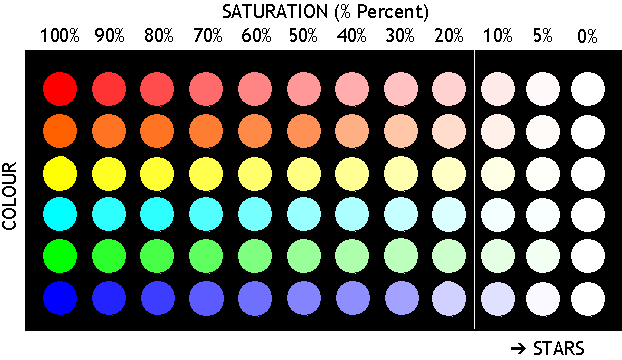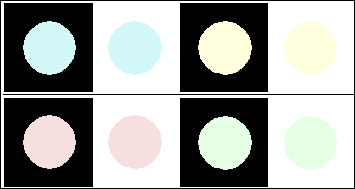STAR COLORS“The form is the body of the color, ’
|
| -3 | Pure Blue |
| -2 | Pale Blue (Bluish) |
| -1 | Blue / White |
| 0 | Pure White |
| 1 | Yellowish/white |
| 2 | Pale Yellow (Yellowish) |
| 3 | Pure Yellow |
| 4 | Orange /Yellow |
| 5 | Yellow / Orange |
| 6 | Pure Orange |
| 7 | Reddish / Orange |
| 8 | Orangey / Red |
| 9 | Red / Orange |
| 10 | Pure Red |
Most visual observers tended to use the Hagen Color Index (HCI) which relates closely to stellar surface temperatures and the B-V color Index. No one truly adapted this as an “analytical” method, but as an extra means of determining the “correct” position angle of both the stars, especially when the magnitudes are nearly equal.
Note: The original observer’s designation overrides the estimation of the brightest against the faintest star. This means the designation of A and B components are preset by the discoverer. The HCI has some analytical basis, however, the linearity with visual divisions in quite poor. I.e. The values of say white to yellowish are different from say from blue to bluish or red to reddish.
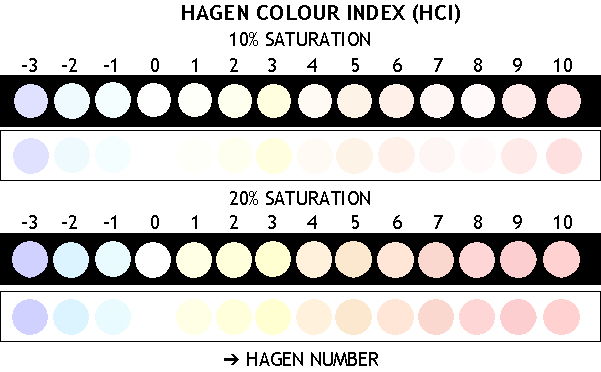
Figure 3. The Hagen Color Index (HCI) - 10% and 20% Saturation
Figure 3 shows the Hagen color Index Scale with both 10% Saturation, the likely maximum visible color, and 20% Saturation. I have contrasted the colors against both black or white backgrounds so the visibility of the colors and the contrast effects can be seen. The Figure above clearly shows these differences. All observed colors will be also slightly different when they are pinpoints, and the color presented here are closer to the defocussed star images that can be seen in the telescope. Observers should note that I have calculated the colors to be approximately 10% and then I have had to make several small adjustments so that the colors look a bit more consistent. However this changes are quite likely inconsequential for many visual observers. Most stars will be fainter than the colors presented here and nearly all of the fainter stars will have almost insignificant saturations.
Anyone using the colors for observational comparison should ONLY use the 10% SATURATION SCALE.
It was M. Minnaert who first discussed star colors in more modern terms. If we assume that star colors are based on the black body properties of objects, as seen in a ultra-hot furnace (I.e. The famous simple experiment it to heat a small piece of metal (like Tungsten) where, as the temperature rises, the metal is colored from red-hot, yellow-hot, white-hot then blue-hot.) we will find this will follow the observed spectral sequence and B-V color index - but without green.
Minnaert then adopted the series of eight separate color groups he could distinguish by eye. He then did a simply blind experiment by comparing his color estimates against the B-V color index, which proved to have a high correlation. From this, he then first achieved the feat of distinguish the spectral class letter of the object. Minnaert gained much kudos for this achievement in his day !
Minnaert also investigated the color of the white and yellow stars, finding that they could distinguish the yellow ones into white-yellow, light yellow, pure yellow and deep yellow. (The reason for this, I think, is that the eye is more sensitive to seeing this part of the spectrum, especially when compared with the red, and the far blue.) Interestingly, his experiments validates the problems of color saturation. His book concludes that only eight major or primary star colors each corresponding to the mid-spectral classes of O, B, A, F, G, K, M, S.
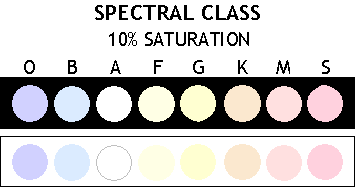
Figure 4. Colors of the Spectral Classification - 10% Saturation
Figure 4 shows the colors of the Spectral Classification at 10% Saturation. The colors can be estimated in the telescope with care, but observers should note that these are the maximum colors and most of the stars have much lower saturated colors. I have contrasted the colors against both black or white backgrounds so the visibility of the colors. The colors here are suitable for using in drawings of star charts where the spectral class is required.
Again, anyone using the colors for observational comparison should ONLY use this 10% SATURATION SCALE.
According to David Malin (AAO), it was the astronomer Leslie Morrison from the Royal Greenwich Observatory who attempted visual observation of stars through the transit telescope, and doing a blind test, could guess the Spectral Class of the star in question! Each class could be seen and ascertained with the eye, with each have only three or four shades of certain colors, with the solitary “non-color” of white. The fourteen “valid” colors in this second system were (in order);
The MINNAERT COLOR SCHEME
| BLUES | WHITES | YELLOWS | ORANGES | REDS |
|
Deep blue Light blue Blue-white |
White |
White-yellow Light yellow Pure yellow Deep yellow |
Yellow-orange Light orange Deep orange Red-orange |
Orange-red Light red Deep red |
DESCRIPTORS FOR DOUBLE STAR COLORS
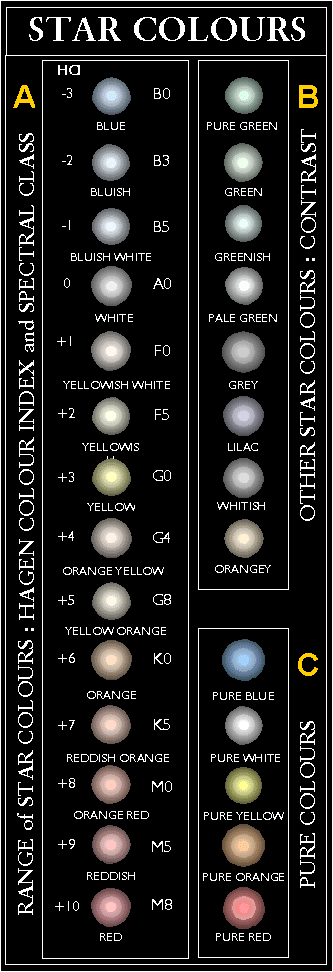
For double star observers such methodologies have been already established using scales like the Hagen Color Index (HCI). This scale has values between -3 and +10, describing the possible range of fourteen double star colors - from blue to white to yellow to orange to red. This roughly mimics the range seen in astronomical spectra, the temperature of the star and the spectral classes. However the problems for double stars that use this particular index, finds the fundamental inherent weakness is a scale is that it does not differentiate between the different color saturations. Furthermore it takes no account of the stellar magnitude. Although this scale is quite arbitrary between observers, different eyes will certainly see different colors. Unfortunately, the HCI system leaves too large a range of observable possibilities for the many different colors. Moreover, detecting color is also very observationally difficult to see as the stars more often than not appear simply as point sources. Often by just simply defocussing the stars into small plate-like disks can be applied to partly exacerbate this problem.
When reading older books, texts and catalogues, you will find more often that they not use the following abbreviations W hite, B lue, Y ellow, O range, P urple, R ed, G reen, C grey, L ilac, A gold, S ashy. With the following additions: p ale - or d eep and the tendency towards any color - sh. So as an example, a yellow star with the color not convincing - Ysh (Yellowish) or Bsh (Bluish).
A further usefulness for this color scheme is that the observer can quickly write down these abbreviations in his or her observation notes. Although the use of color is likely not important, but it is an additional descriptor when checking the pair at a later date or reducing observations.
Later use of the abbreviations now tend to favor the Hagen color Index (HCI), which relates closely to stellar surface temperatures. Using this index, visual observers should report as e.g. “-2 / 3”, being its pale blue primary and pure yellow secondary. Other additional colors were added later I.e. -0.5 for grey and -0.25 for green.
Figure 5. ⇒ (On the
Right-hand Side)
gives the approximate look
of the vast majority of star colors in the
telescope. This is based on 10% color Saturation
given earlier in the text.
A. The White Box on the lefthand side of the Figure shows the Hagen color Index Number, the approximate observed apparent color and the Spectral Class it pertains too.
B. The White Box on the righthand side (at the top) is the reported colors sometimes seen by observers. I have labelled this as due to Contrast Effects because more often than not they are only seen in visual double stars.
C. The White Box on the righthand side (at the bottom) gives the pure monochromatic colors as they would be seen in a telescope. These of course do not exist in Nature and are given as comparison.
REPORTING STAR COLORS : GENERAL RULES
![]() If the color is a definite color, report it as
eg."White" or "Blue" etc.
If the color is a definite color, report it as
eg."White" or "Blue" etc.
![]() If the color seems a definite tint, report it as
eg. "Yellowish" or "Bluish" etc.
If the color seems a definite tint, report it as
eg. "Yellowish" or "Bluish" etc.
![]() If it seems either
like a combination or range of colors report it
as "Bluish" or "Bluish-White"
etc.
If it seems either
like a combination or range of colors report it
as "Bluish" or "Bluish-White"
etc.
![]() If the color can not be described, record it as
"Unusual" or "colorless"
If the color can not be described, record it as
"Unusual" or "colorless"
![]() If the
primary’s color is seen but not the
secondary, record it as "Blue / - " etc.
If the
primary’s color is seen but not the
secondary, record it as "Blue / - " etc.
GREEN STARS
Interesting discussions often appear every now and then regarding the observation of green stars. This is especially prevalent in the observations during the 18th Century, relevant to observers like Admiral Smyth or Rev. T.W. Webb. In my view, the only star that I have really seen to display green was the companion to Antares / α Scorpii, which I thought was really closer to blue than green.
The challenge about the true existence of green stars was likely first eliminated by M. Minnaert “Light and color in the open air.” Dover Publications (1954). If the color green is real in stars, then I would suspect that might be caused by an optical defect of the telescope combined with effects of the eye. An similar example of this effect is what that occurs with visual observations of the planet Mars. For example, Raffaello Braga from the 33-doubles e-group (33-doubles@eGroups.com) told that the;
“...companion of Pulcherrima (Epsilon Bootis) has been sometimes described as green. This is surely a color caused by color contrast that may be perceived when stars are observed with obstructed telescopes, as they tend to diffuse light around the primary component...”
He also reveals, that according to Flammarion, other green stars included the companions of;
“...Zeta Lyr, Gamma Del and Alpha Her.”
Another “classical” green Example commonly described is often Alpha (2) Librae but, I know of no other far southern ones.
The only green I see in any astronomical body are associated with several planetaries and the brightest of the emission nebulae. I.e. The Eta Carinae Nebula (NGC 3372) in Carina or the Orion Nebula, and the outer planets of the Solar System Uranus and Neptune. This is either formed by ionic emission of O-III “forbidden” light or by interaction of light by chemical compounds like Methane.
My main disagreement with the existence of green stars is that the temperature range of these objects falls in the white "A"-type stars where green doesn’t appear in the spectrum of these stars. This is because all the other colors of the spectrum equally "swamp the light" like blue, yellow and red - hence the B-V color index value of 0.0 indicating no color excess.
The only possible way I can think possibly to
producing green stars, being likely close visual
binary stars that has both blue and yellow
components in the magnitude ratio of about 2:3.
Then, the combined visual color color
would be certainly be green. However, I know no
examples of such objects.
I once did a rough search of suitable eclipsing
binaries and even some ellipsoidal systems
(E-II’s), and found only a handful of
examples that met the criteria. However, all were
far too faint for proper visual color assessment.
COLOR VISION and COLOR PROBLEMS
I have read much about what is written about color, and have found some interesting ideas that are worthy for elaboration and clarification. Below is an adaptation of some of my own notes and essays on color, which I have slightly updated for relevance to astronomy and double stars.
COLOR DIFFERENCES BETWEEN THE SEXES
One of the most interesting aspects is on the perception color and the alleged differences between the sexes. Much of this has been generated by the fable that women have some kind of superior vision and color perception. The modern scientific view has shown there are no significant differences between males and females in interpreting color. Most of the current literature also still confirms this view. Recently, colour scientists have shown that the main differences in colour perception between males and females to be more psychological rather than physiological ones. The reasoning follows that for women their mothers and peers from an early age train their daughters and young girls in color perception and color matching, especially after puberty. Subjects are deemed to have improved “perception”, being merely based on their vastly larger and better color vocabulary and knowledge. Naturally women, who are faced with applying face make-up, soon know the subtleties of color and the match of cosmetics to achieve the desirable effects they want. This is also shown in the comparison or matching of many additional fashion accessories like shoes or handbags and with their own clothing.
Men in life are generally not faced with any degree of color matching, and psychologically often do not need or use such color terminology. Others in this field of study say the need for women having the color knowledge improves their “attractiveness” to their male counterparts. Some have said that certain colors, like red, are more noticeable by males. (I.e. Males more often see red on females rather than on other males because they are more aggressive likely from increased use of adrenalin and the male hormone testosterone.) However, no physiological difference has ever been found to influence either the retina’s rods and cones to account for this. Another likely possibility suggests that color may be someway affect by the individual’s emotional state/p>
Again this is more likely an environmental difference. Another explanation maybe to do with brain chemistry and the interaction of with various compounds including hormones and adrenalin release. Though they have made some studies on such mechanisms our understanding on this subject remains quite incomplete. All eyes have the main chemical pigment known as 11-cis Retinal; the principle photo-receptor’s and photosensitive chemical component that is not too unlike the silver halide crystals used in photography, that measure the light intensity. The 11-cis Retinal in the reaction combines with specific proteins, called amino acid glutamates, which then become the color chemical “interpreters” for the photo-receptors. The human brain has acquired these latter proteins for color discrimination and is some cases the erroneous recombinations for the wrong interpretation of color in color defects.
EYE DEFECTS in PERCEIVING COLOR
The main problem with color perception between the sexes is with color blindness. It is found that the so-called anomalous trichromacy that limits 6% of men’s color vision, meaning they are unable to properly discriminate the colors between red and green. Another 2% are so-called dichromats, and are deficient in the pigments needed for discrimination of the both the long and middle wavelengths. Men are also ten times more likely to have some form of color blindness defects than women. Most color blindness is cause by a defect in a specific gene that causes in the eye by either the red or green cones called protanopia, or the less frequently known blue cone defect known as deuteranopia.
Overall, visual color problems are caused in the incorrect usage of the chemical pigments. In simpler terms, it works like a television where the color gun is working incorrectly and, not targeting properly or even has one gun is not functioning at all. I.e. Take out the red component so the colors that are seen are mainly yellows, blues and greens etc.
Total Color Blindness occurs in 1:40 000 individuals, equally between men and women, where the cones do not form from birth. Such persons are sensitive to high intensity light, and have vision that is akin to your surrounds as they appear during normal twilight vision. (Naturally without any color) Sometime others have no rods, and have to rely on their cone vision. These individuals are “night-blind” are medically termed hemeralopes.
Another more general fault is that the spectral range of the visual wavelengths narrows as you age. The cause for this is likely that the rod and cones reduces in number combined with increasing inefficiencies in the chemical signals being sent to the brain. Although the visible impact is minute during the daylight hours because there is overwhelmingly sufficient amount of light, the effects become far more pronounced when less photons are available. I.e. If the color degradation were 25%, for example, and then say some million photons were received in one second of time during daylight hours, the loss of light would be of little consequence as there is enough light available for color discrimination. Yet if a hundred photons were received over the same period the effect would be more dramatic and obvious. To our eyes, this manifests in the gradual loss color so that the sky would becomes more “greyish”. (Note that if this postulate is true, this would have slightly more trouble discerning nebulosity in the telescope as we got older.)
A secondary effect is that the range of observed colors also diminish such that the ability to see blues and reds at either ends of the visible spectrum becomes harder to see. As our eyes as sensitive to red, then you should find that the perceived blues intensity gradually gets slightly lesser over time. This combined with the decreasing light intensity will find that colors become less obvious. I suspect that the age where these effects start happens at an average age of about fifty-year’s old. (See Figure 6)

Figure 6. color Loss With Age
Figure 6 shows the expected explanation for most of the loss of color vision as we age. Although arguably subjective, it does explain what is happening regarding the general discussions about color perception with people of various ages. It is important to note that some people may experience no loss of color at all while others may find the changes and differences suddenly and quite dramatic. Again there is no real “better” or “worst” in this situation and certainly no superior color vision.
GENERAL NOTES ON COLOR DEFECTS
![]() Still unexplained in nature is why color-vision
in humans are similar between the sexes, but is
much more different than the many other
color-visioned mammals. I.e. Apes and monkeys
have known significant differences in color
perception between males and females. Typically,
these primates have males with two types of
color cones dichromats while the females
do have three different color cones or
trichromats. The postulated reason for
this has been something to do with either
behavior modification or being necessary for
mate selection. [Some religious discussions
have used these particular facts against Charles
Darwin’s “Theory of
Evolution”.]
Still unexplained in nature is why color-vision
in humans are similar between the sexes, but is
much more different than the many other
color-visioned mammals. I.e. Apes and monkeys
have known significant differences in color
perception between males and females. Typically,
these primates have males with two types of
color cones dichromats while the females
do have three different color cones or
trichromats. The postulated reason for
this has been something to do with either
behavior modification or being necessary for
mate selection. [Some religious discussions
have used these particular facts against Charles
Darwin’s “Theory of
Evolution”.]
Note: Only 2% of all human males are dichromats - being probably the genetic eye defects from misaligned X-chromosomes.
![]() The chemical proteins for the colored-cone
photo-receptors are attached to the XX and XY.
Interestingly women have a duplication of these
cone receptors while males do not. This
explains the increased number of males that
have imperfect genetically color vision.
However this does NOT mean that females
have, as some submissions I have read have
claimed, of better or “improved”
vision, as the chemical and physical mechanisms
are just the same. In evolutionary terms, our
eyesight maybe one of the earliest to develop
especially as keenness of sight has definite
advantages for hunting animals or spear fishing
for food.
The chemical proteins for the colored-cone
photo-receptors are attached to the XX and XY.
Interestingly women have a duplication of these
cone receptors while males do not. This
explains the increased number of males that
have imperfect genetically color vision.
However this does NOT mean that females
have, as some submissions I have read have
claimed, of better or “improved”
vision, as the chemical and physical mechanisms
are just the same. In evolutionary terms, our
eyesight maybe one of the earliest to develop
especially as keenness of sight has definite
advantages for hunting animals or spear fishing
for food.
![]() color genetic defects in women may mean they
can be so-called tetrachromatic, which
are likely women who have had sons who are
“dichromats”. (Jordan, G., Mollon,
J.D. “A study of women heterozygous for
color deficiencies.”, Vision
Research, 33, 1495-1508 (1993))
Here, they mismatch the colors, and they have
slightly better capabilities in separating red
to orange colors. However, such women are
literally one-in-a-million.
color genetic defects in women may mean they
can be so-called tetrachromatic, which
are likely women who have had sons who are
“dichromats”. (Jordan, G., Mollon,
J.D. “A study of women heterozygous for
color deficiencies.”, Vision
Research, 33, 1495-1508 (1993))
Here, they mismatch the colors, and they have
slightly better capabilities in separating red
to orange colors. However, such women are
literally one-in-a-million.
REFERENCES
1. Malin, David; “The Colors of
the Galaxies”, Pub. Cambridge
University (1996)
2. “color, Art and
Science.” Ed. Trevor Lamb and
Janine Bourriau, Cambridge University Press.
(1995)
a. Baylor, Denis; “Color
Mechanisms of the Eye”;
b. Millon, John; “Seeing
Color”
c. Lyons, John; “Color in
Language”
3. Gerstner, K.;“The Forms of Color - The Interaction of Visual Elements.”; MIT Press (1986)
APPRECIATION
I would like to sincerely thank
Tom Teague, Luis Arguelles, Eddy O’Conner
and Raffaello Braga for their poignant views and
for being the true inspiration for this text on
this page. However, Richard Harshaw deserves
special credit for some really interesting ideas
and innovative solutions regarding the colors
seen in doubles. One or two ideas by Richard
have show pure genius and have forced me to
again question for some time on how to apply
these to stellar observations.
Note: All of the above are members of the
unique 33-doubles Yahoo! Group.
GENERAL COMMENTS
1. The definitions of the primary parameters of color are hue, saturation and brightness. This is where hue is the dominant - just as Wien’s law dictates for the observed colors of stars. In brief the definitions are;
Hue is the discernable color based on the dependant dominate wavelength, independant saturation or brightness.
Saturation is the observed degree of whiteness added to the color.
Brightness is the observed intensity of the visible light from a source.
2. The subject of color and its nature is known
in science of physics as Radiometry, and is
specifically about the measurement of electromagnetic
radiation and light - including the visible portion
of the spectrum. Such measurements, especially in
astronomy, are made using photometry, which
measures and expressses light in terms of radiation
units, like energy (in SI units of Watts), and
radiance and irradiance - being power (watts) per
unit area (I.e. SI units of square meter
(m2 or in units of solid angles,
steradians (sr).
UNITS : Brightness is measured in
the SI units known as lux (lx), as
the numbers of lumens per square meter,
which in astronomical terms is about 0.25
lux for Full Moon, 1 mlx (milli-lux) for dark
moonless night sky, 50 to 80μlx for general
starlight.
The unit of lumens (lm) is more complicated,
being the amount of light (number of photons)
emitted by a uniform source of one candela, that
is spread over the solid angle of one steradian
(sr)
The SI unit of candela (cd) is also a
measure of luminosity intersity of some
monocromatic light source (single color). Few
astronomical sources are known to be
monochromatic.
3. The title of much of the earlier section on green stars I have updated, which appeared in the 33-doubles e-group entitled “It’s Not Easy Being Green”.
I commented “; In regards the color Green, perhaps Kermit the Frog is the only being, in this world, who sees these green colored stars with certainty? (Hence the title...)”
4. I been thinking of proposing an experiment using a series of stars in increasing Right Ascension, in which the observer has to estimate the colors, and this is later correlated with the B-V values. This will give an estimate of the observer’s ability to see colors, and even shades of those colors. It would also test the color acuity of the observer, objectively. Would anyone be interested in such a visual experiment?
5. I have some Double Star Color Estimate results of the seventy-two stars observed by some thirty-two (32) amateurs of the Astronomical Society of New South Wales and other nearby Australian astronomical Society’s. We conducted these, equally among a few northern and many southern pairs. (See Page029d.htm)
6. Luis Arguelles (33-Doubles Communication) commenting on this suggests;
“...as commented by other members of the list, probably it was caused from different cultural roles between males and females. I also think it’s more a question of brain processing than the number of cells in our retinas.”
7. Ric Hill (33-Doubles Communication Message 835: 05th April 2000), was the one who inspired some of the text above. However, there is absolutely no evidence to support his quote below;
“Yes, I remember reading that during WW II a study was conducted by DOD, to determine which were better suited for night watch duty. I can’t remember the source, possibly Science News but if it was then it was from the early 1990’s, or maybe the late 1980’s. Basically, it found that women see color at a lower light level than men but men can see in an overall lower light level than women but it’s all black and white to us. So if you want to see faint galaxies, be a guy. But if you want to see color in the Orion Nebula, be a gal. Sorry ’bout that folks, nature is sexist.”
8. I have studied chemistry and worked for a biscuit company for some sixteen years before leaving several years ago. During 1989, one of my projects was to the set-up for the instrumental measurement of the color of baked biscuits. I was already fairly interested in colorimetry sometime before this, and actually once did a specific course on color including color matching and design. Yet of the seventeen in the class I was the only male, mainly because they designed the course for textiles, cosmetics and fashion. A small portion however was left under architectural design, which I enjoyed the most, but I unfortunately missed a few of these lectures. Much of the earlier work presented was on color measurement (colorimetry) and on the creation and nature of pigments. Once I completed the course, I am now considered a colorist, though over the years I have never called myself this. This is mainly because others have often interpreted the connotations of the title, by me presumably being able to improving there lives by advising matching certain colors to their personalities - the ’astrology’ of the colorist. This knowledge, however, has proved to have certain advantages especially with the opposite sex. I.e. Drumming up a conversation, but I have observed, despite my continued advice, most of them still take absolutely no notice! Furthermore, I still continue to wear the “standard issue” black trousers with bright colored tops and jumpers - and never as the current and costly fashion dictates.
For a continunance of this page:
See Star Colors 2. (Next)
Last Update : 4th August 2012
Southern Astronomical Delights © (2010)




